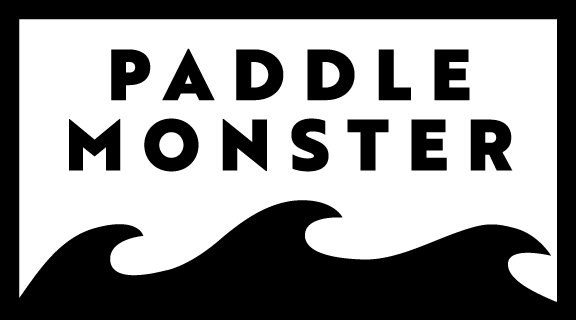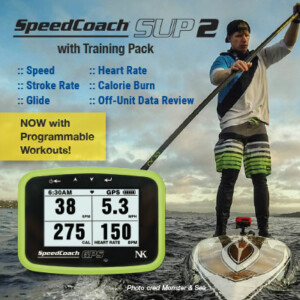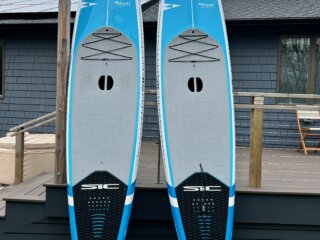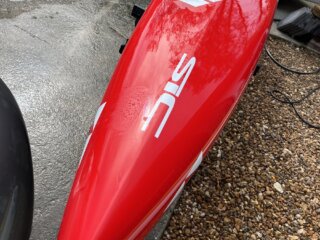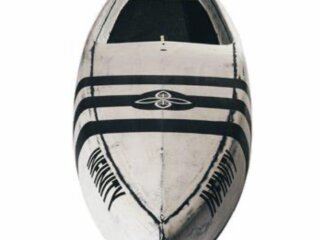
Editor's Note: Bruce Kirkby is a Canadian outdoor adventure athlete, author, professional speaker, talented nordic skiier and SUP paddler and Starboard "Dream Team" member.
British Columbia’s Central Coast by SUP
By Bruce Kirkby
For the last five years, Norm Hann and I have tackled increasingly challenging SUP expeditions along the Canadian Coast. Norm is a former elite Canadian basketball player who has transformed into a leading Paddle Canada SUP instructor, equally comfortable in surf, river and ocean. Best known for his STAND campaign, aimed at helping protect British Columbia’s Great Bear Rainforest, Norm has raced extensively in the past (including M2O) and is rock solid on a paddleboard. After thirty years of guiding rafts and sea kayaks around the world, I bought a 12’6 inflatable a decade ago, and immediately fell in love with this sport. After paddling from Vancouver to Victoria that first summer, I traversed the outer coast of Vancouver Island from Port Hardy to Tofino the next. By fluke, Norm and I shared the stage at a Whistler mountain festival, and immediately recognized a shared love for SUP adventure and wilderness. The next year we followed an ancient First Nation’s Grease Trail, traversing highland portages, class III rapids and long stretches of coast. By the end of that journey, it was clear we made a wonderful and powerful team. The next year we rounded Cape Scott together, and the year after that the notorious Brooks Peninsula. This summer we set our sights on traveling from Bella Bella to Port Hardy, a route weaving through biological rich offshore islands, and past the infamous headlands of Cape Caution.

After a mad rush of packing and traveling north on Vancouver Island, we dragged our boards and dry bags onto a BC Ferry bound for Bella Bella and beyond. As the heavy ship pulled out of Port Hardy at dusk, plowing through Queen Charlotte Strait and out into the vast, heaving expanse of Queen Charlotte Sound, I felt humbled. The reality of what we had chosen to tackle was at hand, and yes, I felt intimidated. Despite more than thirty years of expeditions from Everest to Arabia to Africa’s Blue Nile, it’s not unusual to feel such uncertainty in the moments of departure—and I reminded myself that I’d take whatever came day-by-day and step-by-step, and fundamentally trusted in my partner Norm’s decisions.

The ferry let us off in inky darkness at 1 a.m. and using headlamps, we set up our tent on the edge of the industrial ferry terminal, at high tide. The next morning, after visiting a few of Norm’s friends in the nearby First Nation’s community of Bella Bella, we loaded the boards with over 80 pounds of gear, food and water (enough for 10 days) and paddled off. Our SUPs felt heavy and tippy, our muscles sore as they adjusted to the new load, but we managed to bang off 40 kilometers before taking refuge in a small sandy bay, setting up camp in the cathedral-like forest.

A low-pressure storm hit the coast that night, and we stayed hunkered on firm land the next day as gales lashed the outer waters and the marine radio reported seas building to 4 metres. Tucked under a tarp, I plowed through 90% of the only book I brought; Peter Heller’s Whale Wars. (My god, Heller can write, and this tale of Sea Shepherd’s efforts in the Antarctic should be required reading for anyone with a heart.)
Norm and I have a well-established food program on our trips; oatmeal and coffee for breakfast; bars, Landjaeger sausage, dried fruit and sandwiches during day; dehydrated meals for dinner, along with chocolate and tea. There were a few noteworthy updates on this journey. First, my wife sent me off with little Ziplocs of dehydrated peanut butter and banana flakes, which we added to our oatmeal. Weighing almost nothing, these vastly improved our breakfast! Also, we’ve always eaten bagels for lunch, but this year Norm picked up two bags of pitas instead. They packed well, lasted well, felt more filling, and carried more cheese and sausage--always room for menu improvement!
Our foundational rule of trip food is this: Always eat your best meal.
It sounds crazy, but this is how it works. On Day 1, you look forward to, and then eat, your very best meal. It’s wonderful. Then on day 2, the same things happens; you eat your very best meal. And so on. Every day brings the best food left in the bags.
It wasn’t always this way for me. Brought up with a Scottish, Puritanical ethic, I felt I should save the good food until I deserved it… later in the trip. But inevitably, some of the really great stuff would go rotten. Or we’d finish the trip early and never get to it. And I also learned that on Day 10 or 20 of a long trip, anything tastes great. So, trust me on this. It sounds counterintuitive, but always eat your best food first. It’s the only way!
On the third day, we nosed out from the bay, and tested the open waters of Superstition Point. With 3 metre swell and gusty winds still hammering the outer headland, we had to work hard to make it around. In the hours ahead, we stuck to protected waters whenever we could. The shores around us were sheer rock, and after many hours of exhausting paddling—both mentally and physically—we still hadn’t passed a single beach to haul out on. By 6 pm, with the open waters of Hakai Pass ahead, we needed to stop for the night. But where? There was nothing shown on chart, and we were rapidly running out of options. Then Norm happened to duck behind a tiny island while I went out around it. An excited shout brought me back, and there in the protected lee, hidden from the main channel, was the smallest pocket beach I have ever seen—the ancient remains of a clam and mussel midden. Yanking wet gear from our bags, we sprawled across it, happy to be on solid ground, but uncomfortably aware that despite a lot of effort, we hadn’t made much headway yet on our journey, and the clock was ticking.

Day three was an absolute cracker. We cranked out 52 km in 9.5 hours, watching as beds of sea stars, urchins, cucumbers and mussels drifted beneath our boards in crystal clear waters, met a small pod of transient orca, crossed the wide-open waters of Fitz Hugh Sound, and camped on one of the best beaches I’ve ever seen to cap the day off. We had put ourselves in a good position for the big moves coming up. As sunset showered the coast with golden light, we finally broke out our precious Nalgene of Scotch.
The next morning, after crossing the open waters of River’s Inlet, we found ourselves hammered by swell, wind, chop and rebound. At one point I glanced down at my GPS, and despite absolute max effort, we were crawling forward at 2 km/h. It took two exhausting hours to reach refuge in a sandy bay. We waited patiently for six hours, hoping the winds would ease, finally launching uncertainly near sunset to race down another 10km of outer coast. Landing on a tiny beach after 9 pm, we cooked a hurried dinner, then crawled into the tent with alarms set for 5 am.
We hadn’t gotten as close to Cape Caution as we would have liked, but with a forecast of ‘light winds’ for the following day (anyone who follows marine forecasts will know how rare and lucky this is), we had put ourselves in a good position to round the notorious headland the next morning.
We rose the next morning at 4 am, in the murky light of pre-dawn, cutting across the wide mouth of Smith Sound, then down increasingly exposed coastline—past Hoop Bay, past Neck Ness—towards Cape Caution. The sea was eerily flat, and the winds calm. Fog swirled around us, and we often had to rely on our deck compasses. Aware the weather could turn on a dime, we both wondered how long such calm conditions could last. We wove through reefs and past sheer cliffs, until suddenly a white navigation marker loomed ahead—the tip of Cape Caution.
Many of my friends have survived epics at Cape Caution, fighting 30-foot waves, exploding boomers, currents and clapotis (when incoming and rebounding waves collide to create exploding mountains of water.) Aware of our luck, we paused and gave thanks, as a pair of busy sea otters splashed in the mirror-like waters. We both wore protection necklaces of Devil’s Club, made by the extraordinarily talented and generous Heiltsuk artist Blake Carpenter. Before the trip, Norm and I had contacted the Heiltsuk Nation, humbly asking permission to travel in their traditional territory. While it can be difficult knowing who to approach in these situations, I’d urge everyone traveling through wild landscapes to consider doing the same. It is the right and respectful thing to do, and it’s important.
Then we raced on, not wanting to press our luck. Ahead of us lay some of the most gorgeous, sprawling beaches I’ve ever seen. We paddled late into the day, riding the high that came from knowing Cape Caution now lay behind us. Eventually, we hauled the boards atop a rocky islet.

Day Seven brought pea soup fog, and we launched with no idea how far we’d get, unwilling to start fantasizing about burgers and warm showers with so many big open-water crossings ahead. But as forecast winds never appeared, and Queen Charlotte Straight turned to glass, it became apparent we were going to hit the finish line. We’d packed for ten days, but wrapped the 230 km journey up in seven.

If you have any questions about SUP touring, please don’t hesitate to contact Norm or myself. We both work hard to share the joys of this sport as broadly as we can, as well as important aspects of safety. Norm offers excellent guided experiences in wilderness settings (www.normhann.com). We continue to work closely with our sponsors-- Sunova (Norm), Starboard (Bruce), Blackfish Paddles, Mustang Survival—to create the most functional and efficient SUP touring equipment possible. Perhaps in a follow-up article I’ll write a bit more about our philosophy of packing and loading SUPS for long trips, and the gear we bring. But for now, I hope you find an opportunity to explore our precious waterways and coastlines by SUP—it is another glorious aspect to the sport we all love.

Paddle Events
DeSatnick Foundation Around the Cape Paddle
Ohio River Paddlefest Races
The Circumnavigation-Tilghman Island 2024
Recent Classifieds
2 Boards: Both SIC Bullet 12’6″ x 28.5″
- Sell
- 4 days ago
- Stand Up Paddleboard
- 02813 Charlestown , Rhode Island United States
- 71 views
SIC XRS 14 x 22
- Sell
- 1 week ago
- Stand Up Paddleboard
- Chattanooga , Tennessee United States
- 108 views
Wanted! Ocean / downwind 14 foot SUP
- Buy
- 1 week ago
- Stand Up Paddleboard
- Main Street , 07005 Boonton , New Jersey United States
- 99 views
one edge pro 2.0 hollow 14′ x 23.5”
- Sell
- 1 week ago
- Stand Up Paddleboard
- 53066 Oconomowoc , Wisconsin United States
- 129 views
2021 Starboard Allstar 14×24 5
- Sell
- 1 week ago
- Stand Up Paddleboard
- 21085 Joppatowne , Maryland United States
- 109 views
Subscribe for Premium Content and Coaching
Join the Paddle Monster paid Plan Today!
You May Also Like


The Island Paddler: How (and Why) I Became a Voyager

